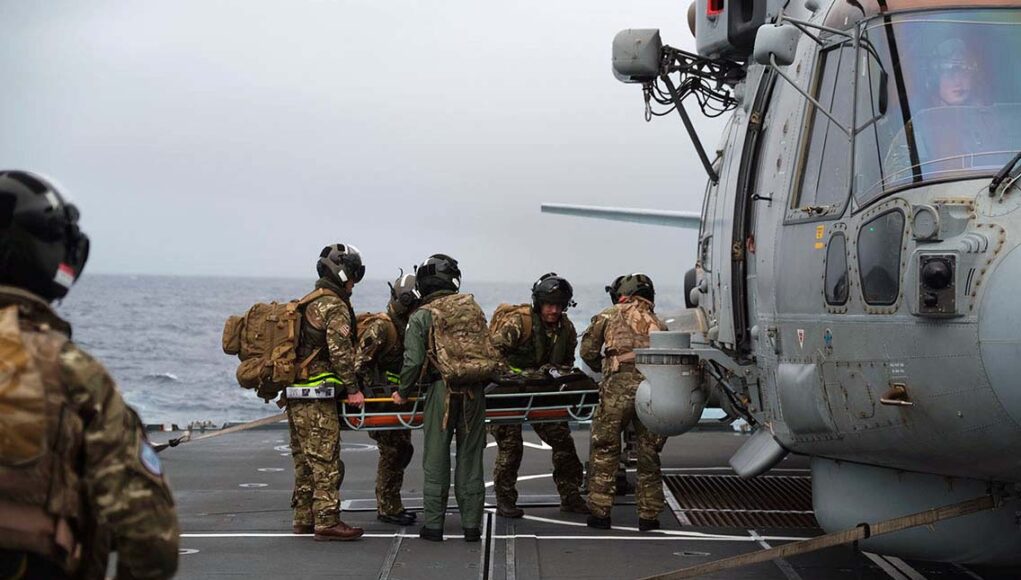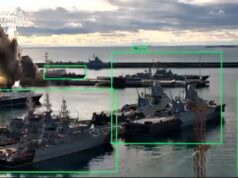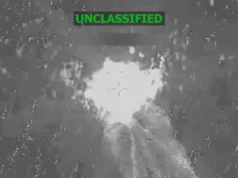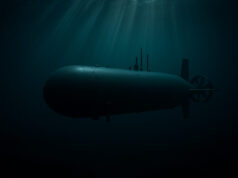Medics onboard HMS Queen Elizabeth have tested a ‘military air ambulance’ at sea concept that will operate the next time a Royal Navy carrier group goes into action.
The Royal Navy say here that HMS Queen Elizabeth used her autumn deployment to the North Sea and Scandinavia to test the ‘air ambulance’ concept, mirroring the emergency service provided by the NHS but at sea.
“The new Maritime Medical Emergency Response Team or MMERT flies a small team of casualty experts directly to the injured person by helicopter, provides on-the-spot life-saving care, then deliver them to a hospital for further treatment… be that ashore or the sick bay on an aircraft carrier.
MMERT was tested in an exercise with Queen Elizabeth’s escort HMS Richmond: a ‘casualty’ in the engine room suffered injuries more severe than those the frigate’s sick bay team could cope with, requiring the A&E expertise of the MMERT team, and ultimate transfer to the flagship.”
Paramedic Warrant Officer 1 Phil Towers was quoted as saying:
“The exercise provided an excellent opportunity to test the developing Maritime Medical Emergency Response Team capability. The team was composed of a Royal Navy medical consultant, paramedic and a medical assistant. Maritime MERT provides advanced trauma care far forward ¬– equivalent to the care provided by UK air ambulances – including senior clinical decision making, anaesthesia and blood products.”
You can read more on this here.














‘ to test the ‘air ambulance’ concept, mirroring the emergency service provided by the NHS but at sea.’
Hate to be picky but around London, at least, the air ambulance is a charity and I don’t believe it is significantly NHS core funded.
‘But only 38 per cent of Londoners know that London’s Air Ambulance is primarily funded by public donations. As a charity, London’s Air Ambulance relies on 89 per cent of its funding from people like you to be able to save London’s most critically injured.4 Oct 2022’
The air ambulances are all set up as charities (bit like the RNLI) with the NHS providing staff for free. Exception is Scotland where in addition to a helicopter charity theres a light aircraft and helicopter operation directly by the NHS to ferry passengers to mainland/England for treatment. The Channel Island and Manx governments also directly operate patient air transport.
You have added to my knowledge!
So George’s comment was probably based around Scotland: which then makes total sense!
Without delving too deeply into Google, I think all air ambulances up and down the country rely on charitable donations. I know of one organisation which donated £2million to the London Air Ambulance service, plus further payments of hundreds of thousands.
The RNLI is also a critical service which relies almost completely on donations.
I can’t imagine life without these purely voluntary services, which the UK Government seem to regard as a fact of life and don’t appear to offer any real financial support. I stand corrected, of course.
These services want to remain voluntary… the RNLI say that all the time. It means they get the best kit and best research.
Turn it to public funding and it becomes run for the lowest price… not something you want when your life depends on it
Agree, Chris. I once did some voluntary work in the fund raising dept of a local hospice. They said the very same – they would not be able to give the brilliant service they do now, if Govt bean-counters were involved.
All the air ambulance services are charities and not publicly funded. Scotland relied on the Fleet Air Arm/RAF Sea Kings but I am unsure about the current position. It is not a moan about Scotland but having done some significant fund-raising in the past for the two Yorkshire Air Ambulance helicopters it used to really rankle me.
Surrey Air Ambulance is one which I donate monthly towards.
ahh – I sense some local county bias.👌 Good on you Mare well done! ,
:wpds_smile:
I’m interested in this. Is this supposed to be about getting task force personnel back to the R2 on the carrier or deployed troops ashore?
MERT saved the lives of at least 10 of my Riflemen, but the real life saver was it was about 15 mins flying time to the R2 in Bastion (well 45 mins on HERRICK 9). If it’s carrier based you’d probably be struggling with the golden hour or your carrier has to be really close in so you’d have to assume a permissive environment.
But to counter act my own points, if you’re war fighting in high intensity, MERT is not what you want, because the casualties would be too high in number, you have to secure the airspace, declare a RAS which limits your fires and secure the LZ – all of which takes combat power from the fight. What you need is a rapid land based CASEVAC chain and R2 as forward as possible. That enables you to recycle and maintain momentum as quickly as possible.
Yes, that is a very interesting point about the golden hour.
Isn’t the point of having Argus, or something like her, closer with the Albions and the Bays?
Thought this was at least part of the rationale for RFA Argus’ extension in service?
But Argus is rerolling to a LSS, so the ship is staying but the capability….
It says in the article about a ‘casualty’ in a frigates engine room so I would say it is primarily about casualties in the carriers task force.
There’s also the angle of reversing how you’re viewing this. Instead of ground forces out to the carrier look at RN/ RM personnel taken from a sea bourne setting to a land facility.
I imagine the QMs have pretty good surgical suites but it may not be enough at times so land based rapid transfer might be the better option. Yes of course this would require the nessecary environment so would have limiting factors but as an example let’s imagine we have well established command bases on land with wide area safety, multiple operating theatres and much more surgical staff on hand ( say Bastion) and a sailor suffers a partial or whole amputation. They could be stabilized on the QM then moved rapidly to a location with better and broader facilities which would increase patient survivability and improve the chances of the injuries having a lower long term impact.
Yep that’s all very fair. To be clear, I’m not knocking the concept, I’m just interested in what they’re intending to use it for. What you don’t want to do necessarily is put very high value assets like surgeons into harms way in a contested environment. The pay off has to be worth it (as it was on HERRICK because the threat to airframes was actually quite low, but the opportunity to save lives of troops was high).
This would be news in what way? This concept has been around for about 70 years now… Let’s try harder.
maybe less moaning, hey maybe you should pop a few articles out??
Oh dear your limited knowledge of the subject is showing. How’s the chip, chippy?
On the face of it, it is a good idea, in peacetime, yes, use it. It will save lives and life changing injuries. Having used the services of the Air Ambulance a few times, I suspect they will have to kit out some dedicated airframes. This will result in those no longer being available for the fleet in other areas.
In areas of vulnerability when it kicks off in a hot zone. Would you really consider flying such skilled people out to a casualty when in a conflict. Take the Falklands as an example. 14 helicopters were lost (not counting those on Atlantic Conveyor). Only 2 were to enemy fire. If taking such highly skilled medics out of the safe confines of a ship or field hospital, one needs to ask, can they be risked? Rotary aircraft crash in war all the time, when you look at how long it takes and how valuable these people are to morale, I believe it’s a risk too far. Keep them protected, yes, people will die in transport, but they may have died anyway, The number of close shaves found in after action checks during Afghanistan. Those Chinnoks we’re riddled with rounds.